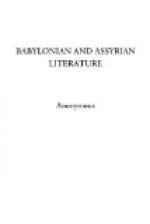1 They are seven! they are seven! 2 In the depths
of ocean they are seven! 3 In the heights of heaven
they are seven! 4 In the ocean stream in a Palace
they were born. 5 Male they are not: female
they are not! 6 Wives they have not! Children
are not born to them! 7 Rule they have not!
Government they know not! 8 Prayers they hear not!
9 They are seven, and they are seven! Twice over
they are
seven!
This wild chant touches one of the deepest chords of their religious feeling. They held that seven evil spirits at once might enter into a man: there are frequent allusions to them, and to their expulsion, on the tablets. One runs thus:
1 The god (...) shall stand by his bedside:
2 Those seven evil spirits he shall root out, and
shall expel
them from his body.
3 And those seven shall never return to the sick
man again!
But sometimes this belief attained the grandeur of epic poetry. There is a fine tale on one of the tablets [Footnote 2: “Cuneiform Inscriptions of Western Asia,” vol. iv. pl. 5.] of the seven evil spirits assaulting heaven, and the gods alarmed standing upon the defensive, no doubt successfully, but unluckily the conclusion of the story is broken off.
ANCIENT BABYLONIAN CHARMS
TRANSLATED BY REV. A.H. SAYCE, M.A.
The following are specimens of the imprecatory charms with which the ancient Babylonian literature abounded, and which were supposed to be the most potent means in the world for producing mischief. Some examples are given in the first volume of the “Records of the Past,” pp. 131-135 of the exorcisms used to avert the consequences of such enchantments. The original Accadian text is preserved in the first column with an interlinear Assyrian translation: the short paragraphs in Column III also give the Accadian original; but elsewhere the Assyrian scribe has contented himself with the Assyrian rendering alone. The charms are rhythmic, and illustrate the rude parallelism of Accadian poetry. The Assyrian translations were probably made for the library of Sargon of Agane, an ancient Babylonian monarch who reigned not later than the sixteenth century B.C.; but the copy we possess was made from the old tablets by the scribes of Assur-bani-pal. The larger part of the first column has already been translated by M. Francois Lenormant in “La Magie chez les Chaldeens” p. 59. The tablet on which the inscription occurs is marked K 65 in the British Museum Collection and will be published in the “Cuneiform Inscriptions of Western Asia,” Vol. IV, plates 7, 8.
ANCIENT BABYLONIAN CHARMS
COLUMN I




